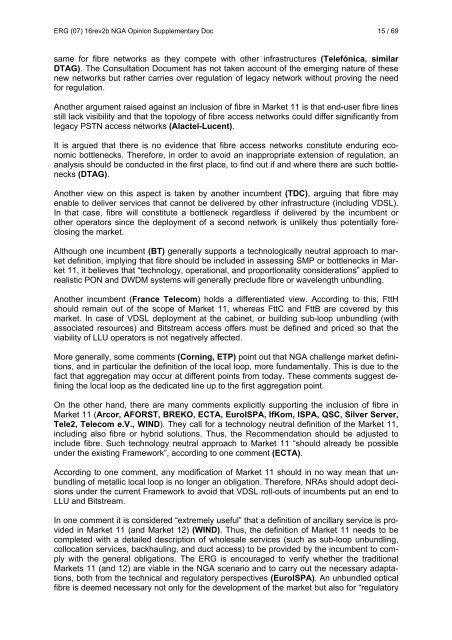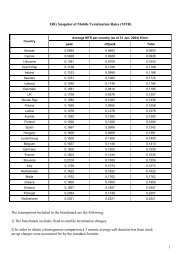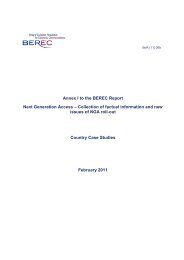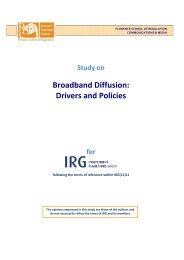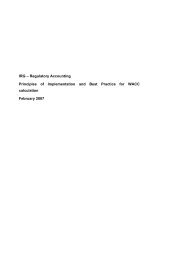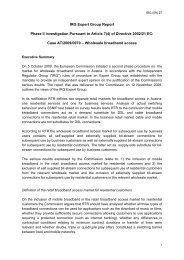16 Rev2b NGA Opinion Supplementary doc - IRG
16 Rev2b NGA Opinion Supplementary doc - IRG
16 Rev2b NGA Opinion Supplementary doc - IRG
You also want an ePaper? Increase the reach of your titles
YUMPU automatically turns print PDFs into web optimized ePapers that Google loves.
ERG (07) <strong>16</strong>rev2b <strong>NGA</strong> <strong>Opinion</strong> <strong>Supplementary</strong> Doc 15 / 69<br />
same for fibre networks as they compete with other infrastructures (Telefónica, similar<br />
DTAG). The Consultation Document has not taken account of the emerging nature of these<br />
new networks but rather carries over regulation of legacy network without proving the need<br />
for regulation.<br />
Another argument raised against an inclusion of fibre in Market 11 is that end-user fibre lines<br />
still lack visibility and that the topology of fibre access networks could differ significantly from<br />
legacy PSTN access networks (Alactel-Lucent).<br />
It is argued that there is no evidence that fibre access networks constitute enduring economic<br />
bottlenecks. Therefore, in order to avoid an inappropriate extension of regulation, an<br />
analysis should be conducted in the first place, to find out if and where there are such bottlenecks<br />
(DTAG).<br />
Another view on this aspect is taken by another incumbent (TDC), arguing that fibre may<br />
enable to deliver services that cannot be delivered by other infrastructure (including VDSL).<br />
In that case, fibre will constitute a bottleneck regardless if delivered by the incumbent or<br />
other operators since the deployment of a second network is unlikely thus potentially foreclosing<br />
the market.<br />
Although one incumbent (BT) generally supports a technologically neutral approach to market<br />
definition, implying that fibre should be included in assessing SMP or bottlenecks in Market<br />
11, it believes that “technology, operational, and proportionality considerations” applied to<br />
realistic PON and DWDM systems will generally preclude fibre or wavelength unbundling.<br />
Another incumbent (France Telecom) holds a differentiated view. According to this, FttH<br />
should remain out of the scope of Market 11, whereas FttC and FttB are covered by this<br />
market. In case of VDSL deployment at the cabinet, or building sub-loop unbundling (with<br />
associated resources) and Bitstream access offers must be defined and priced so that the<br />
viability of LLU operators is not negatively affected.<br />
More generally, some comments (Corning, ETP) point out that <strong>NGA</strong> challenge market definitions,<br />
and in particular the definition of the local loop, more fundamentally. This is due to the<br />
fact that aggregation may occur at different points from today. These comments suggest defining<br />
the local loop as the dedicated line up to the first aggregation point.<br />
On the other hand, there are many comments explicitly supporting the inclusion of fibre in<br />
Market 11 (Arcor, AFORST, BREKO, ECTA, EuroISPA, IfKom, ISPA, QSC, Silver Server,<br />
Tele2, Telecom e.V., WIND). They call for a technology neutral definition of the Market 11,<br />
including also fibre or hybrid solutions. Thus, the Recommendation should be adjusted to<br />
include fibre. Such technology neutral approach to Market 11 “should already be possible<br />
under the existing Framework”, according to one comment (ECTA).<br />
According to one comment, any modification of Market 11 should in no way mean that unbundling<br />
of metallic local loop is no longer an obligation. Therefore, NRAs should adopt decisions<br />
under the current Framework to avoid that VDSL roll-outs of incumbents put an end to<br />
LLU and Bitstream.<br />
In one comment it is considered “extremely useful” that a definition of ancillary service is provided<br />
in Market 11 (and Market 12) (WIND). Thus, the definition of Market 11 needs to be<br />
completed with a detailed description of wholesale services (such as sub-loop unbundling,<br />
collocation services, backhauling, and duct access) to be provided by the incumbent to comply<br />
with the general obligations. The ERG is encouraged to verify whether the traditional<br />
Markets 11 (and 12) are viable in the <strong>NGA</strong> scenario and to carry out the necessary adaptations,<br />
both from the technical and regulatory perspectives (EuroISPA). An unbundled optical<br />
fibre is deemed necessary not only for the development of the market but also for “regulatory


